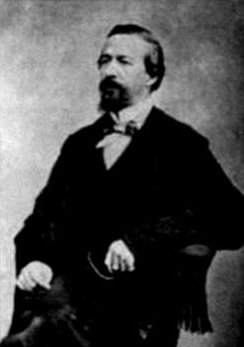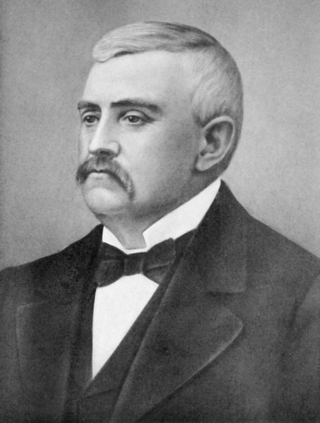
The Battle of Tupelo, also known as the Engagement at Harrisburg, was a battle of the American Civil War fought from July 14 to 15, 1864, near Tupelo, Mississippi. The Union victory over Confederate forces in northeast Mississippi ensured the safety of Sherman's supply lines during the Atlanta Campaign.

William Wirt Adams (1819–1888) was a banker, planter, state legislator, and a Brigadier General in the Confederate States Army.
The 17th Wisconsin Infantry Regiment was an infantry regiment that served in the Union Army during the American Civil War. It was popularly known as the Irish Brigade, due to its composition of mostly Irish American immigrants.
The 7th Kansas Cavalry Regiment was a cavalry regiment that served in the Union Army during the American Civil War.
The 1st Missouri Infantry was an infantry regiment that served in the Confederate States Army during the American Civil War. Originally commanded by Colonel John S. Bowen, the regiment fought at the Battle of Shiloh, where it was engaged near the Peach Orchard on April 6, 1862. On April 7, during the Union counterattacks at Shiloh, the regiment was instrumental in preventing the Washington Artillery from being captured. The regiment was next engaged at the Second Battle of Corinth, where it outflanked several Union positions. On the second day at Corinth, the regiment was only minimally engaged. On November 7, the 1st Missouri Infantry was combined with the 4th Missouri Infantry to form the 1st and 4th Missouri Infantry (Consolidated), as a result of heavy battle losses in both regiments.

The 9th Arkansas Infantry Regiment was a regiment of the Confederate States Army during the American Civil War. It served in the Western Theater, seeing action in the Vicksburg, Tennessee and Georgia campaigns. Due to attrition; the 9th Arkansas was consolidated several times with other Arkansas regiments, finally merging in 1865 into the 1st Arkansas Consolidated Mounted Rifles.

The 23rd Arkansas Infantry (1862–1865) was a Confederate Army infantry regiment during the American Civil War. In the summer of 1864, the unit was reorganized as a mounted infantry regiment in preparation for Price's Missouri Expedition and officially redesignated as the 42nd Arkansas Infantry (Mounted). The unit was often referred to as Lyle's Arkansas Cavalry in report from Price's Missouri Expedition. Due to its mounted status, the unit is also occasionally referred to as the 23rd Arkansas Cavalry Regiment.
The 11th Missouri Infantry Regiment was an infantry regiment that served in the Union Army during the American Civil War.
The 43rd Mississippi Infantry Regiment was a regiment of infantry in the Confederate States Army. It fought in many battles and campaigns of the American Civil War. It was known as "The Camel Regiment" after its mascot, Douglas the camel.

Lyman Munson Ward was an American farmer, Republican politician, and Union Army colonel in the American Civil War. He served four years in the Michigan House of Representatives, and received an honorary brevet to brigadier general after his service in the war.
The 1st Arkansas Cavalry Battalion (Stirman's) (1864–1865) was a Confederate Army cavalry battalion during the American Civil War. The unit was also known as Brooks 1st Arkansas Cavalry Battalion, Stirman's, 1st Arkansas Cavalry Battalion, Stirman's Sharpshooter Regiment, 1st Regiment Arkansas Sharpshooters, and finally simply as Stirman's Arkansas Cavalry Regiment.

The 9th Texas Cavalry Regiment was a unit of mounted volunteers that fought in the Confederate States Army during the American Civil War. The regiment fought at Round Mountain and Bird Creek (Chusto-Talasah) in 1861, Pea Ridge, Siege of Corinth, Second Corinth, Hatchie's Bridge and the Holly Springs Raid in 1862, and in the Atlanta campaign, Franklin, and Murfreesboro in 1864. The unit fought dismounted at Second Corinth and Hatchie's Bridge before being remounted as cavalry for the remainder of the war. The regiment surrendered to Federal forces on 4 May 1865 and its remaining personnel were paroled.

The 3rd Texas Cavalry Regiment or South Kansas-Texas Mounted Volunteers was a unit of mounted volunteers that fought in the Confederate States Army during the American Civil War. The regiment fought at Wilson's Creek and Chustenahlah in 1861, Pea Ridge, Corinth siege, Iuka, Second Corinth, and the Holly Springs Raid in 1862, Thompson's Station in 1863, and at Yazoo City, in the Atlanta campaign, and at Nashville in 1864. The regiment fought dismounted at Iuka and Second Corinth before being remounted for the rest of the war. The regiment surrendered to Federal forces in May 1865 and its remaining 207 men were paroled.

The 3rd Louisiana Infantry Regiment was a unit of foot soldiers from Louisiana that fought in the Confederate States Army during the American Civil War. The regiment distinguished itself at Wilson's Creek in 1861. The 3rd Louisiana fought at Pea Ridge, First Corinth, Iuka, and Second Corinth in 1862. The unit defended Vicksburg in 1863 where it was captured. At Vicksburg, the unit's fortification was twice blown up by powerful land mines. The surviving soldiers were paroled and exchanged, after which they performed guard duty for the rest of the war.

The 6th Missouri Infantry was an infantry regiment of the Confederate States Army during the American Civil War. The regiment was formed on August 26, 1862, when two existing units were combined. Later that year, the regiment was then lightly engaged at the Battle of Iuka and saw heavy action at the Second Battle of Corinth. In 1863, the regiment was engaged at the Battle of Port Gibson, and was part of a major charge at the Battle of Champion Hill. After a defeat at the Battle of Big Black River Bridge, the regiment took part in the siege of Vicksburg, where it saw heavy fighting. The siege of Vicksburg ended on July 4 with a Confederate surrender; after being exchanged, the regiment combined with the 2nd Missouri Infantry to form the 2nd and 6th Missouri Infantry (Consolidated). The 6th Missouri Infantry ceased to exist as a separate unit.
The 4th Missouri Infantry Regiment was formed on April 28, 1862, and served in the Confederate States Army during the American Civil War. The infantry regiment did not see action at the Battle of Farmington on May 9, and the Battle of Iuka on September 19 despite being part of the Confederate force present at those battles. As part of Brigadier General Martin E. Green's brigade, the regiment participated in three charges against Union lines on October 3, 1862, during the Second Battle of Corinth. The following day, the regiment, along with the rest of Green's brigade, attacked the new Union lines. Despite initial success, the attack was repulsed by a Union counterattack. The regiment ceased to exist as a separate unit when it was combined with the 1st Missouri Infantry Regiment on November 7, 1862, to form the 1st and 4th Missouri Infantry Regiment (Consolidated).
The 2nd Missouri Infantry Regiment was an infantry regiment that served in the Confederate States Army during the American Civil War. Organized on January 16, 1862, the regiment first saw major action at the Battle of Pea Ridge on March 7 and 8, 1862. After Pea Ridge, the regiment was transferred across the Mississippi River, fighting in the Battle of Farmington, Mississippi on May 9. The unit missed the Battle of Iuka in September, but was heavily engaged at the Second Battle of Corinth on October 3 and 4. The regiment helped drive in a Union position on October 3. On October 4, the 2nd Missouri Infantry, along with the rest of Colonel Elijah Gates' brigade, captured a fortification known as Battery Powell, but were forced to retreat by Union reinforcements.
The 3rd Missouri Infantry Regiment served in the Confederate States Army during the American Civil War. The infantry regiment was officially mustered into service on January 17, 1862. It fought at the Battle of Pea Ridge in Arkansas in March before being transferred across the Mississippi River. While stationed at Corinth, Mississippi, the regiment played a minor role in the Battle of Farmington before the evacuation of the town. In September, the unit saw light action at the Battle of Iuka before being heavily engaged during the Second Battle of Corinth as the Confederates attempted to retake the town in October. In early 1863, the regiment was transferred to Grand Gulf, Mississippi, in order to strengthen the defenses of the Mississippi River at that point. At the Battle of Grand Gulf on April 29, the unit helped repulse a Union Navy attack against the Confederate defensive works. After elements of the Union Army of the Tennessee landed below Grand Gulf, the regiment fought in a delaying action at the Battle of Port Gibson on May 1.
The 6th Mississippi Infantry Regiment was a unit of the Confederate States Army that fought in many battles of the Western theater of the American Civil War. After taking heavy casualties at the Battle of Shiloh, the 6th Regiment fought in the Vicksburg Campaign, operations against anti-Confederate guerillas in Jones County, Mississippi, the Atlanta campaign, and the Franklin-Nashville campaign.

Hinche Parham Mabry Jr., also known as "Hinchie" Mabry and H.P. Mabry was a Texas lawyer, state legislator, judge, and brigade commander in the Confederate States Army during the American Civil War. After joining the Confederate army, Mabry was promoted to colonel and assigned command of a cavalry brigade in Forrest's Cavalry Corps. Mabry's brigade fought against Union forces in Mississippi until the late stages of the war. During Reconstruction, Mabry returned to his home in Jefferson, Texas, where he was the leader of a KKK-style terror organization called the Knights of the Rising Sun. Mabry was implicated in lynchings committed by the group in 1868, but he was never prosecuted.










